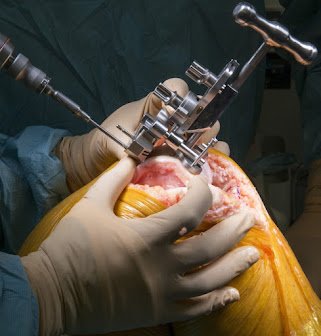.
Knee replacement surgery, also known as knee arthroplasty, is a procedure in which damaged parts of the knee joint are replaced with artificial components, called prostheses. These implants can be made from metal, plastic, or ceramic materials and are designed to restore the function of the knee.
What are the Types of Knee Replacement Surgeries?
There are primarily two types of knee replacement surgeries:
- Total Knee Replacement (TKR): The entire knee joint is replaced with artificial components.
- Partial Knee Replacement (PKR): Only the damaged portion of the knee is replaced, preserving the healthy parts of the joint.
Who Needs Knee Replacement Surgery?
Knee replacement is typically recommended for people suffering from:
- Severe osteoarthritis: The most common reason for knee replacement.
- Rheumatoid arthritis: An autoimmune condition causing joint inflammation.
- Post-traumatic arthritis: Joint damage following a severe injury.
- Knee deformity: Severe deformities affecting movement and quality of life.
- Persistent pain and stiffness: When non-surgical treatments (medications, physical therapy) fail.
If knee pain interferes with daily activities, and conservative treatments like physical therapy and medications are no longer effective, knee replacement might be the best option.
Preparing for Knee Replacement Surgery
Before undergoing surgery, it’s crucial to prepare both physically and mentally:
Consultation with an Orthopedic Surgeon: The first step involves a thorough consultation with a top knee surgeon to discuss your condition, medical history, and potential benefits/risks of the surgery.
Medical Evaluations: You’ll likely need a physical exam, X-rays, blood tests, and possibly an MRI to assess the extent of knee damage.
Preoperative Physical Therapy: Engaging in exercises before surgery can help strengthen the muscles around the knee, speeding up post-operative recovery.
Plan for Recovery: Arrange for a comfortable home environment and seek assistance from family or caregivers during the initial recovery phase.
The Knee Replacement Surgery Procedure
Here’s a step-by-step breakdown of what happens during the surgery:
Anesthesia: The surgeon will discuss anesthesia options, typically either general anesthesia or regional anesthesia (spinal/epidural).
Incision and Removal of Damaged Tissue: An incision is made over the knee to access the joint. The damaged bone and cartilage are carefully removed.
Placement of Implants: The artificial components are inserted to recreate the joint surface, ensuring smooth motion.
Closing the Incision: The surgeon closes the incision with sutures or staples and may place a drain to remove excess fluid.
The entire procedure typically lasts 1-2 hours, but recovery varies based on individual factors.
Recovery After Knee Replacement Surgery
The recovery process is a critical phase in achieving successful outcomes. Here’s what to expect:
Immediate Post-Surgery
- Hospital Stay: Most patients stay in the hospital for 2-3 days after surgery. You’ll begin physical therapy almost immediately to prevent stiffness.
- Pain Management: Pain and discomfort are common but manageable with medications prescribed by your surgeon.
- Mobility: You’ll likely use a walker or crutches for the first few weeks to avoid putting weight on the knee.

